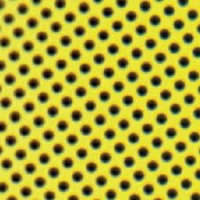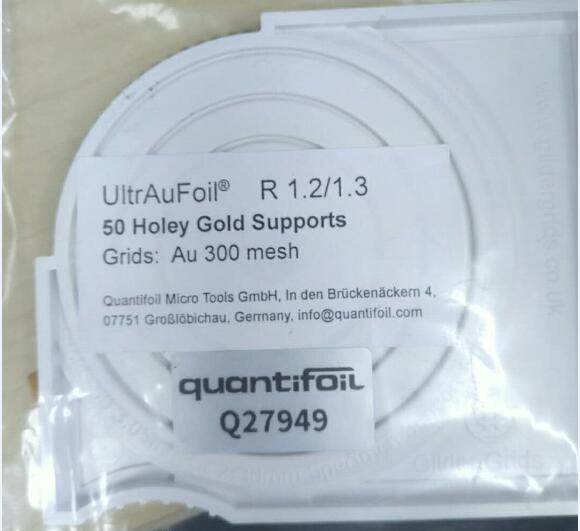

UltrAuFoil® 金网金膜可以减少成像过程中冷冻标本的运动,这一点可以显著改善图像对比度和质量,从而能以更少的数据实现更好的3D重建。在低温成像过程中,传统的碳载体会移动,特别是在辐射开始时。 这种运动模糊了图像,使得难以确定小型和具有挑战性的分子的结构。
| Thickness of gold foil | About 500 Å | |
| Structure of gold foil | Regular square array of micrometer-sized circular holes | |
| Available geometry | R 1.2/1.3 (Other types available on request) | |
| TEM grid | Gold 300 mesh (Other grids available on request) |

Because it is a highly conductive, nonoxidizing, radiation-hard material whose surface is chemically inert and biocompatible.
400-500 Å is optimal because it minimizes motion as much as thicker layers, but still gives thin ice films under typical blotting conditions. Below 400 Å the performance of the gold support foils begins to degrade.
Using the same metal eliminates differential thermal contraction during cooling of the sample and therefore prevents changes in the geometry and tension of the support foil.
The UltrAuFoils® should be stored in a grid storage box, in a dark, cool and low-humidity environment. Generally there is no date of expiry, but we recommend to use them within two years.
No, they are ready for use when delivered. They can be made more hydrophilic using standard glow discharge and plasma systems or other gold surface treatments.
Currently, the recommended electron beam geometry is circularly symmetric beam, centered on the hole, which encompasses a small region of the support around each hole. The micrograph is taken in the center of the hole.
Since there is no amorphous material in the gold support structure, Thon rings cannot be used to focus. As discussed in the publication, several other options are available, but the two simplest are:
1. Turn on beam tilt wobble and minimize the image shift.
2. Look for the diffracted beams at the edge of a hole with the objective aperture removed. When the shift between the diffracted beams and the crystals of gold is minimized, the foil is in focus.
We recommend using a calibration specimen to correct the stigmation and beam tilt prior to collecting data on UltrAuFoils®.
Yes, automated data collection has been successfully tested on UltrAuFoils® using beam tilt to focus.
No, they are similar or less fragile than traditional carbon foils. But if mishandled with tweezers or broken during freeze plunging, the stability of the support may be severely degraded. We recommend collecting data only from squares where the foil is uniform and intact.
Yes. Standard float transfer methods work fine for transferring thin films of carbon onto UltrAuFoils®.

· 地址:上海市嘉定区安亭镇墨玉路185号1层J565室
· 邮箱:jessica.yang@tem-sem.com
